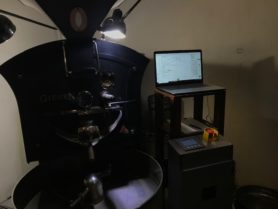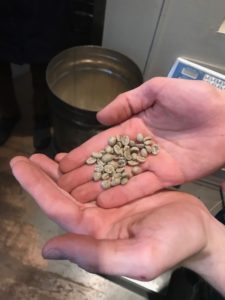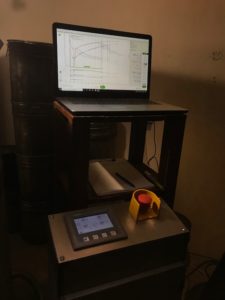Data walking in Düsseldorf: A quick write up on the datafication of coffee bean roasting
by Karin van Es
For the 2020 Annual Meeting of the Association for Cultural Management conference I was asked to organize a data walk. With four other participants we walked the city center of Düsseldorf using the theme “ownership” to frame our conversations as we defined, observed and reflected on data. The first fifteen minutes sparked several thoughtful discussions on the relationship between data and information, and also between the material and digital (in)material. As the walk commenced, we noticed that many store fronts and cafes compelled passersby into creating a connection (enabling them access to their data) either by offering free WiFi, asking for a like on their Facebook page or inviting them to be part of their rewards program. We started taking photos of visible cameras (CCTV or via the web etc.) and noted that these cameras were owned by a variety of parties including the police, banks, art museum, store owner and home owners/renters. This prompted talk about the layered and fragmented nature of public space; penetrated by the data infrastructures of corporate, private, public and semi-public actors. It got us thinking about power asymmetries. “They” can look at us, but can we look back? When taking photos, engaging in a form of looking back (albeit a very limited kind, in that there was no way of knowing who was on the other side and what happened to this footage), we felt we had broken an unspoken code of conduct and that any moment someone might confront us and ask that we stop.
 After walking in the cold for 40 minutes we sought refuge in a specialty coffee store. Heading to the upstairs seating area we witnessed a café employee in front of a Giesen coffee roaster, armed with a laptop and an interface panel, roasting coffee beans. Intrigued by the real-time dashboard on the laptop, we asked if it was okay to take photographs. He ended up explaining the roastery process a bit and answering several of our questions. It was a short crash course, and although I missed bits of the conversation that were in German, here are some quick reflections:
After walking in the cold for 40 minutes we sought refuge in a specialty coffee store. Heading to the upstairs seating area we witnessed a café employee in front of a Giesen coffee roaster, armed with a laptop and an interface panel, roasting coffee beans. Intrigued by the real-time dashboard on the laptop, we asked if it was okay to take photographs. He ended up explaining the roastery process a bit and answering several of our questions. It was a short crash course, and although I missed bits of the conversation that were in German, here are some quick reflections:
 There was a certain tension between the artistry and the science of roasting; between the ability to look through a glass portal in the machine at the coffee beans and smell the aroma filling the room versus tracking and watching roast values on the laptop (e.g. four temperatures and rate of rise in bean temperature over time). It created a juxtaposition between human sensing and machine sensors. In explaining the roasting process, the young man placed a lot of emphasis on how the color of the coffee beans changed with roasting. And after he released the beans into the cooling tray, he commented on the quality of the batch based on its smell (it was perhaps roasted a bit over).
There was a certain tension between the artistry and the science of roasting; between the ability to look through a glass portal in the machine at the coffee beans and smell the aroma filling the room versus tracking and watching roast values on the laptop (e.g. four temperatures and rate of rise in bean temperature over time). It created a juxtaposition between human sensing and machine sensors. In explaining the roasting process, the young man placed a lot of emphasis on how the color of the coffee beans changed with roasting. And after he released the beans into the cooling tray, he commented on the quality of the batch based on its smell (it was perhaps roasted a bit over).
 We learned that the store had been using tools from Cropster Roasting Intelligence for the past six years. Amongst other things, it allows the staff to compare multiple roasts on key roast values (e.g. air pressure, gas/volume, water activity). In response to the question if all this historical data was stored and available to them, the roaster replied yes, but that many of the beans used in the past were, of course, no longer available and those roasts were therefore not replicable. The Siemens SIMATIC HMI panel (situated next to an impressive red button to halt the process) provided some of the same metrics as seen on the laptop (centered on real-time temperature). But unlike the laptop, he actively used it to adjust settings and finalize the roasting. Interestingly (as seen in the photo) amidst these technologies lay a clipboard with grid paper and pen. Unfortunately, we don’t know what was registered here and if it was of any significance.
We learned that the store had been using tools from Cropster Roasting Intelligence for the past six years. Amongst other things, it allows the staff to compare multiple roasts on key roast values (e.g. air pressure, gas/volume, water activity). In response to the question if all this historical data was stored and available to them, the roaster replied yes, but that many of the beans used in the past were, of course, no longer available and those roasts were therefore not replicable. The Siemens SIMATIC HMI panel (situated next to an impressive red button to halt the process) provided some of the same metrics as seen on the laptop (centered on real-time temperature). But unlike the laptop, he actively used it to adjust settings and finalize the roasting. Interestingly (as seen in the photo) amidst these technologies lay a clipboard with grid paper and pen. Unfortunately, we don’t know what was registered here and if it was of any significance.
Was roasting possible without the laptop? The employee remarked that coffee beans had long been roasted without – it was simply a matter of keeping track of time and temperature. Then why use technology? To this he replied: “It’s the 21st century!” Afterwards, reading the Cropster website, the roasting intelligence company, it became apparent that its rhetoric centers on improving quality and ensure uniformity and consistency.
All in all it proved a rewarding data walk that expanded our thinking on datafication and incited many questions worthy of further research.

